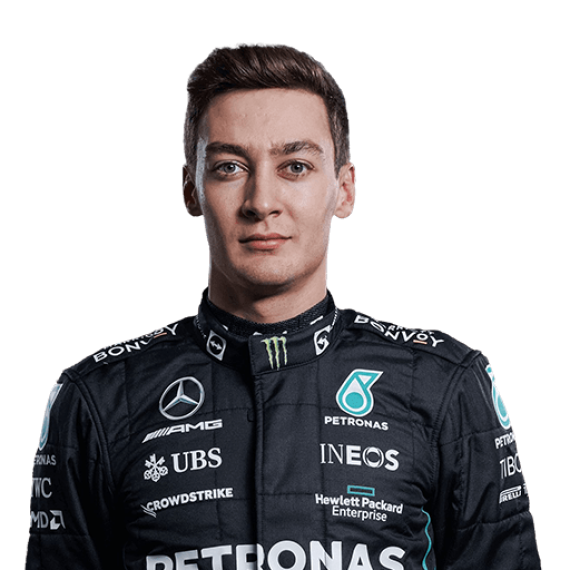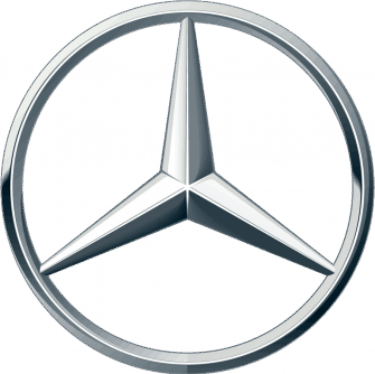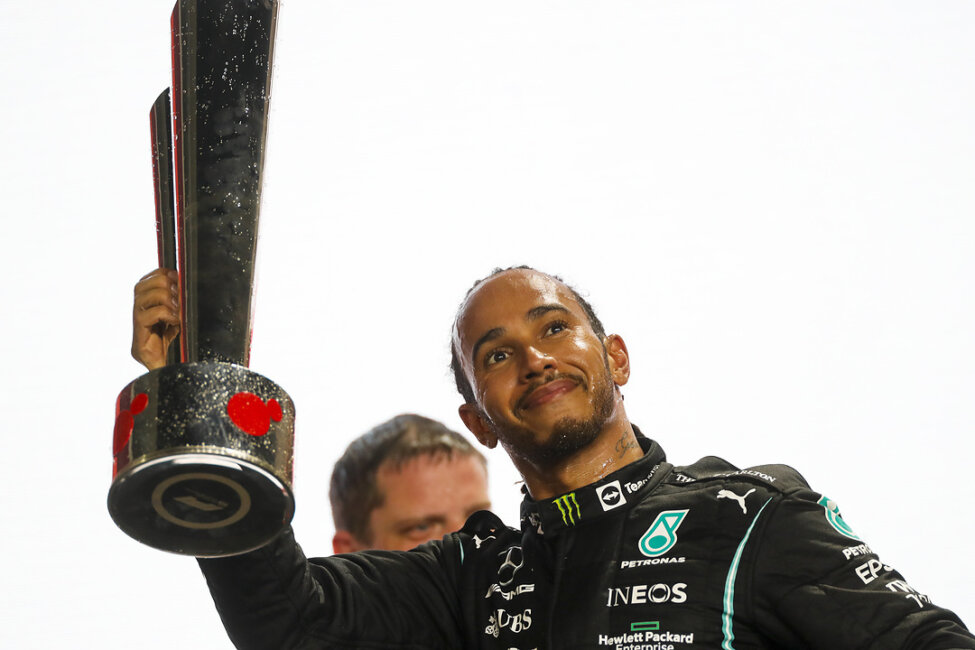The Mercedes Formula 1 team head into the 2022 season with the new driver line-up of Lewis Hamilton and George Russell, as the German racing team hope to claim a record ninth Constructors’ Championship in a row.





Mercedes AMG F1
Hamilton & Russell
F1 season 2022
| WC Position | 3 |
| WC points | 188.0 |
| Podiums | 5 |
| Pole positions | 0 |
F1 history
| World titles | 9 |
| WC Points | 6486.5 |
| Podiums | 269 |
| Pole positions | 137 |
Early F1 success and withdrawal from motorsport
German manufacturer Mercedes have a rich history in Formula 1. Whilst the team’s heritage can be traced back to the 1930s, their first foray into what was by then the official Formula 1 championship came in 1954.
Under the leadership of Alfred Neubauer, the team ran the Mercedes-Benz W196 that featured a conventional open-wheeled configuration and a streamlined form. Mercedes experienced instant success with Juan Manuel Fangio, who joined from Maserati mid-season in time for the French Grand Prix. The Argentine took the chequered flag ahead of teammate Karl Kling, with Fangio adding another three wins during the rest of the season to claim the title.
That success continued in 1955, as Mercedes dominated once again. Fangio won four races, while teammate Stirling Moss took the chequered flag at the British Grand Prix. The Argentine finished ahead of his teammate in the standings to take his second Drivers’ Championship.
However, the 1955 disaster at the 24 Hours of Le Mans killed Mercedes-Benz driver Pierre Levegh, along with 80 spectators, and resulted in the cancellation of the French, German, Spanish and Swiss Grands Prix. Mercedes opted to withdraw from the world of motorsport, including F1, at the end of the season.

© Daimler
Return to F1 after Brawn GP purchase
Mercedes-Benz’s parent company Daimler AG bought a minority stake in the Brawn GP team prior to the start of the 2010 F1 season. A sponsorship deal with Petronas was then struck, with the team rebranded as the Mercedes GP Petronas Formula 1 team. Ross Brawn was kept on as Team Principal, while the outfit continued to use the same base and workforce in Brackley, close to the engine plant in Brixworth.
Prior to that, the squad can trace its history back to Tyrrell Racing, who competed in Formula 1 from 1970 to 1998. British American Tobacco then bought the team, so its entry became British American Racing in 1999, and the outfit were eventually known as Honda Racing F1 Team in 2006.
Ownership changed hands again in 2008 when Honda withdrew from the sport, with Ross Brawn buying the team and renaming it Brawn GP. Jenson Button won six of the first seven races en route to winning the Drivers’ Championship, while Brawn won the Constructors’ Championship in part thanks to their Mercedes engines.

© Mercedes
Mercedes return with all-German line-up featuring Schumacher
Mercedes brought in the German duo of Nico Rosberg and Michael Schumacher – with the latter returning to F1 after a three-year absence – to be their driver pairing in 2010, while Nick Heidfeld was named as test and reserve driver.
The purchase of Brawn GP saw Mercedes end their association with McLaren, as parent company Daimler AG sold back their 40 percent stake in the McLaren Group, though they continued to supply the team with engines.
Unfortunately, Brawn GP’s prior success didn’t carry over to 2010, as Mercedes were unable to challenge the likes of Ferrari, McLaren and Red Bull. Rosberg achieved three podium finishes in Malaysia, China and Great Britain, but Schumacher failed to register a win, podium, pole position or fastest lap for the first time since his debut F1 season in 1991.
In the end, Mercedes finished fourth in the Constructors’ Championship with 214 points.
Daimler AG and Aabar Investments, who purchased 30 percent of Brawn GP in November 2009, bought the remaining 24.9 percent in February 2011. The new car, known as the MGP W02, got off to a slow start in 2011, with both Rosberg and Schumacher retiring from the Australian Grand Prix due to damage sustained in a crash.
Rosberg led 14 laps of the Chinese Grand Prix, while Schumacher finished fourth in Canada after running second for a period of time. By the season’s end, Mercedes once again found themselves fourth in the standings, with 165 points and no wins, podiums or poles.
The 2012 season saw Mercedes remove GP from their name and add AMG, making them Mercedes AMG Petronas F1 Team. Rosberg claimed the team’s first pole since Fangio in 1955 at the third race of the season in China, while Schumacher, who qualified third, was promoted to second following Lewis Hamilton’s grid penalty.
Rosberg took the victory, the team’s first win in 57 years. Schumacher, though, was forced to retire after he left the pit lane before his right front tyre was properly fitted. Rosberg’s win was also the first by a German driver in a German vehicle since Hermann Lang’s 1939 Swiss Grand Prix victory.
Schumacher finished third at the European Grand Prix, his only podium after returning to F1. At the age of 43 years and 173 days, the result made him the oldest driver to achieve a podium since Jack Brabham’s second-place finish at the 1970 British Grand Prix.
However, with the German unsure about his Formula 1 future, Mercedes announced that Hamilton would join the team on a three-year contract to partner Rosberg from 2013 onwards. Soon after, Schumacher confirmed his second retirement from the sport, with Mercedes ending the season fifth in the standings.

© Mercedes
Mercedes’ fortunes change with the arrival of Hamilton and Wolff
Prior to the start of the 2013 season, Toto Wolff was named as Mercedes’ Executive Director, with business partner Rene Berger becoming Non-Executive Director. Wolff also took over the co-ordination of all Mercedes-Benz motorsport activities, a role previously held by Norbert Haug.
Mercedes claimed their first win of the season in Monaco, with Rosberg finishing ahead of eventual champion Sebastian Vettel and his Red Bull teammate Mark Webber. Hamilton claimed third in Canada, whilst Rosberg took a second win at the British Grand Prix following a 1-2 qualifying performance by the team. Hamilton won his first race for the outfit in Hungary, a result that helped Mercedes to finish ahead of Ferrari with P2 in the Constructors’ Championship.
F1 introduced 1.6-litre turbocharged V6 engines with a built-in recovery system in 2014, marking the beginning of the hybrid era. The change seemed to propel Mercedes to the front of the grid. Rosberg took victory in the opening race of the campaign in Australia, while Hamilton completed a Grand Slam victory in Malaysia ahead of his teammate, making it Mercedes’ first 1-2 finish since the 1955 Italian Grand Prix.
Mercedes’ dominance continued throughout the season, with the team clinching the Constructors’ Championship in Russia, while Hamilton finished 67 points ahead of Rosberg to take the Drivers’ title. The Silver Arrows ended the year with 18 poles, 16 wins and 11 1-2 finishes out of 19 races. On average, the nearest non-Mercedes car finished 23.2 seconds back during their 16 victories.
Both drivers returned in 2015, with Hamilton winning his third World Championship by 59 points over Rosberg. The Briton finished the season with 10 wins, while Rosberg added another six to Mercedes’ tally. As such, the Silver Arrows cruised to another Constructors’ Championship, though their average winning margin over non-Mercedes competitors decreased to 19.7 seconds.
The only blemish on this was the growing rivalry developing between Rosberg and Hamilton. At the United States Grand Prix, Hamilton aggressively forced his teammate wide at Turn 1, though Rosberg then led in the closing stages. A mistake at Turn 12 opened the door for Hamilton to win and clinch the title. After the race, television cameras in the cool-down room captured Hamilton tossing the P2 podium cap over to Rosberg, prompting Rosberg to immediately throw the cap back at his teammate.
Whilst Mercedes’ on-track success continued into 2016, the already strained relationship between Rosberg and Hamilton continued to sour. Rosberg won the opening four races of the season and took advantage of his teammate’s slow start to the campaign, opening up a 43-point lead ahead of F1’s return to European soil.
However, Max Verstappen ended Rosberg’s run in Spain, becoming the youngest race winner on his debut for Red Bull. His victory was aided by the fact that Hamilton and Rosberg collided on the opening lap while fighting for the lead, resulting in both Mercedes cars retiring for the first time since the 2011 Australian Grand Prix. From there, Hamilton answered back, winning six of the next seven races to once again put himself in contention for the title.
Unfortunately for the Briton, Rosberg clinched four wins from the next five races. On the lone event he didn’t win in Malaysia, the German finished third and, championship-wise, was helped by Hamilton retiring with an engine failure whilst leading. Rosberg didn’t look back from there, winning the World Championship by five points over Hamilton. Mercedes cruised to another Constructors’ Championship, having amassed 19 wins, 20 pole positions and eight 1-2 finishes from 21 races.

© Mercedes
Rosberg retires but Mercedes dominance continues
Shortly after winning his only F1 World Championship, Rosberg announced his retirement from the sport at the age of 31. That made him the first reigning champion to do so since Alain Prost in 1993.
Valtteri Bottas was announced as the German’s replacement. Unlike in previous years, the battle for the title wasn’t an all-Mercedes affair in 2017, as Hamilton was challenged by Ferrari’s Sebastian Vettel. The Briton trailed by 14 points after Round 11 in Hungary. However, Hamilton then took five wins from the final nine races, whilst Vettel retired twice.
In the end, Hamilton claimed the title by 43 points, becoming the first British driver to win four World Championships, while Bottas clinched three victories in his first year with the team.
The fight between Hamilton and Vettel continued into 2018, with the German ahead by eight points after taking the chequered flag at the British Grand Prix. However, Vettel retired whilst leading the next race in Germany, and Hamilton took victory despite starting from 14th on the grid. It was then smooth sailing for the Briton, who won the title with an 88-point advantage.
Mercedes won their fifth straight Constructors’ Championship that year, becoming the second team to do so after Ferrari achieved the feat between 2000 and 2004. The team finished the year with 11 wins (all for Hamilton), 13 poles and four 1-2 finishes.
Ferrari’s performance tailed off in 2019, making it an all-Mercedes battle for top spot. There wasn’t much of a fight, though, as Hamilton won his sixth title by 87 points from Bottas. The Silver Arrows took another Constructors’ Championship, finishing 235 points ahead of Ferrari. Mercedes ended the year with 15 wins, with 11 for Hamilton and four for Bottas.
The start of the 2020 Formula 1 season was pushed back to July due to the coronavirus pandemic but, once it got started, there was no stopping Hamilton. The Briton won 11 of the 17 races to take his seventh World Championship, putting him level with Michael Schumacher on the all-time list.
Bottas finished second with two wins, while Mercedes took the Constructors’ title yet again after finishing 254 points ahead of Red Bull, having earned 13 wins, 15 poles and five 1-2 finishes from 17 races.

© Mercedes
Tough competition from Red Bull in 2021
After several years of dominance in Formula 1, Mercedes faced their strongest competition for some time in 2021, with Red Bull and Max Verstappen proving to be tough opponents.
The team were slightly on the back foot at the beginning of the campaign following some struggles in pre-season testing, with team boss Toto Wolff saying that the Silver Arrows had had a “terrible” start to the year.
Despite this, Hamilton still managed to qualify on the front row for the opening Grand Prix in Bahrain, and then went on to win the race. Further victories followed in Portugal and Spain, but Red Bull then claimed five consecutive wins from Monaco onwards, with four for Verstappen and one for Sergio Perez.
This set the title battle up for being a closely-fought one between the two sides, and there was no shortage of controversial moments along the way. One in particular occured at the British Grand Prix, where Hamilton and Verstappen collided on the first lap of the race.
Verstappen crashed out heavily, whilst Hamilton was able to stay in running but received a 10-second time penalty for the incident. He still went on to win the event, though.
Hamilton’s next win did not come until the Russian Grand Prix in September, whilst Bottas claimed his only victory of the season in Turkey, which came after it was announced that the Finn would leave the team at the end of the season to join Alfa Romeo. George Russell was confirmed as his replacement.
The fight for the championship became even more intense as the season reached its latter stages, with Hamilton taking three consecutive wins in Brazil, Qatar and Saudi Arabia. This resulted in the Briton arriving at the finale in Abu Dhabi on equal points with Verstappen, whilst Mercedes had a lead over Red Bull in the Constructors’ standings.
Hamilton looked strong in the race, and seemed to be on course to claim a record eighth World Championship. However, a late Safety Car call in the final laps of the Grand Prix allowed Verstappen to pit for fresh Soft tyres and overtake Hamilton – running on older Hard tyres – on the last lap.
This enabled Verstappen to take the race win, and with it the title. Mercedes were unhappy with the manner in which the last laps of the race had played out, and initially lodged two separate protests with the stewards, one against Verstappen and the other against the result of the Grand Prix.
Both were thrown out, and the team signalled an intention to appeal. However, they later decided against this, though welcomed the FIA’s decision to investigate what happened.
Whilst Hamilton missed out on the World Championship in 2021, Mercedes won a record eighth consecutive Constructors’ Championship.

© Mercedes
New rules and a different line-up in 2022
With a wave of new technical regulations being introduced into the sport, Formula 1 could look a little different in the 2022 season. James Allison, Chief Technical Officer at the Silver Arrows, has admitted that the squad have effectively “reinvented” their car ahead of the upcoming campaign.
There will also be a changed look at Mercedes in terms of their driver line-up. After five years with Bottas as his teammate, Hamilton is now joined by George Russell, who steps up to the team after three seasons with Williams.
This partnership has prompted much speculation over how the dynamic will work. Some have predicted that Russell’s arrival will make life more difficult for Hamilton, whilst others, including former F1 driver David Coulthard, believe that Hamilton should have the measure of the younger driver.

